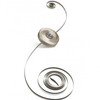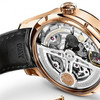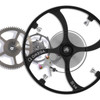We welcome anyone interested in or passionate about watches! Accept our invitation to join us on a long but meaningful journey. Driven by an unquenchable passion for timepieces—especially those worn on the wrist—we are launching a blog that will guide you step by step through the dense jungle of information into the unique universe of the watchmaking world.

WHAT MAKES A MECHANICAL WATCH TICK?
The question posed in the title may not sound interesting, but anyone familiar with the world of watches knows that it is actually a rather complex matter. As with the most interesting and best inventions, the more we know about watches, the more we realize their complexity and beauty. But don't be alarmed, let's take a closer look!
For many of us, just the sight of a mechanical movement — whether it comes from dismantled old Prim watches, family heirloom pocket watches, a fantastic depiction of the mechanism on a YouTube video, or the back of a wristwatch enclosed in sapphire glass — has caused an explosion of enthusiasm and a desire for further knowledge. You've experienced it too, right?
By the way, to keep the excitement alive, here is one of the most fascinating videos showing first-class watchmaking:
But if you are really interested in watches and take your enthusiasm seriously, then it would be appropriate to know how mechanical watches actually work, i.e. what drives them.

HOW DO MECHANICAL WATCHES WORK?
We wind them up, they make a ticking sound, and they start running. That's about it. However, if we want to be more knowledgeable about this topic, then we also know that we are winding up a spring coiled like a cocoa snail, in other words, the main spring. (1). We wind it by turning the crown, or it winds itself thanks to a rotor that spins back and forth due to the movement of our hand and gravitational energy – but only in the case of automatic movements with weights. A spring wound in this way, like all wound springs in general, wants to immediately shoot out and return to its original position – and it is precisely this tension that is the source of energy that powers the watch.
In 15th-century Europe, clever minds figured out how to direct this tension of the spring into a circle and use it to drive a system of gears. Modern mechanical watches also work on this principle: the tightly wound "cocoa snail" in the center wants to expand outward, but it can only do so by rotating around its own axis.

Let's devote the last paragraph to the spring: in the upper picture, we can see its condition before assembly. This spring will be stretched with great precision and pressed into the "mainspring barrel," or, in watchmaker's slang, the "spring barrel" in the middle of the picture. As you can see, it is not an ordinary ballpoint pen spring, but in principle, they function in the same way.

However, without any regulation, the spring would fire on its own within a few seconds, resulting in a short and inaccurate timer. Therefore, the next step is the "going train," a system of gears (2) and a stepping mechanism that, thanks to precisely calculated ratios, transforms 6 to 8 revolutions per hour into 28,800 frequencies (we will look at this in a moment). Just like a car transmission, it works great here too.
As you can see in the picture above, each gear wheel consists of not one, but two. There is one large gear wheel that immediately catches your eye, and a small wheel that plays second fiddle, nestled on the axle of the large one. Two are needed because, if we look more closely at the golden wheels, we can see that they are positioned above or below each other and drive each other's toothed shafts.

Three cogwheels in the gear train are followed by a fourth, like a servant to its masters, an inconspicuous wheel that meets a smaller one, which is the "escape wheel" (3). This wheel has teeth shaped like boots, which catch T-shaped forks that continuously stop and then release the entire system of gears, allowing energy to be drawn from the main spring in small doses. Without this, as we mentioned at the beginning, the spring would fire immediately.
The last element of this structure is the flywheel, the "balance wheel" (4, picture above), an oscillator. It oscillates not sideways, but around its axis to the right and then to the left. An average watch performs 5, 6, 8, or in exceptional cases 10 oscillations per second (so in the latter case, 5 times to the left and 5 times to the right). Time is not tangible, its constant flow must be divided into equal parts, which is the task of the balance wheel. It decides when the entire gear system can move and, in connection with it, when the hands of the clock can move.
And yet: how is it possible that a system of cogwheels can produce such an accurate timepiece? The answer is simple. The entire system of cogwheels was calculated so that the center wheel would rotate around its own axis only once every 12 hours. By precisely layering and connecting the wheels to the previous wheel, it is also possible to drive the minute hand and – voila! – we have a complete display of hours and minutes. The second hand also works on this principle.
In short: the main spring winds up, the system of gears drives, the step wheel brakes, and the flywheel distributes.

SUMMARY
If you are starting to feel a little lost in all this, then you are doing something very well: you are beginning to understand how sophisticated and complex a mechanical device is. And that is why it will be such a wonderful experience not only to see and understand it, but also to own it! Don't forget how many countless complications, how many peculiarities and oddities are involved in designing even a basic mechanical machine with two or three indicators (i.e., hours-minutes or hours-minutes-seconds). If you now understand from the pictures shown above how energy is transferred from the spring to the flywheel, you have taken a small but very important step towards a better understanding and appreciation of these gems that watches undeniably are. We will deal with the details many more times, and the above will serve as a good foundation for you in the future.
Thanks to this knowledge and more that we are preparing for you, we hope that choosing, buying, and owning a watch will be an even greater experience for you!





